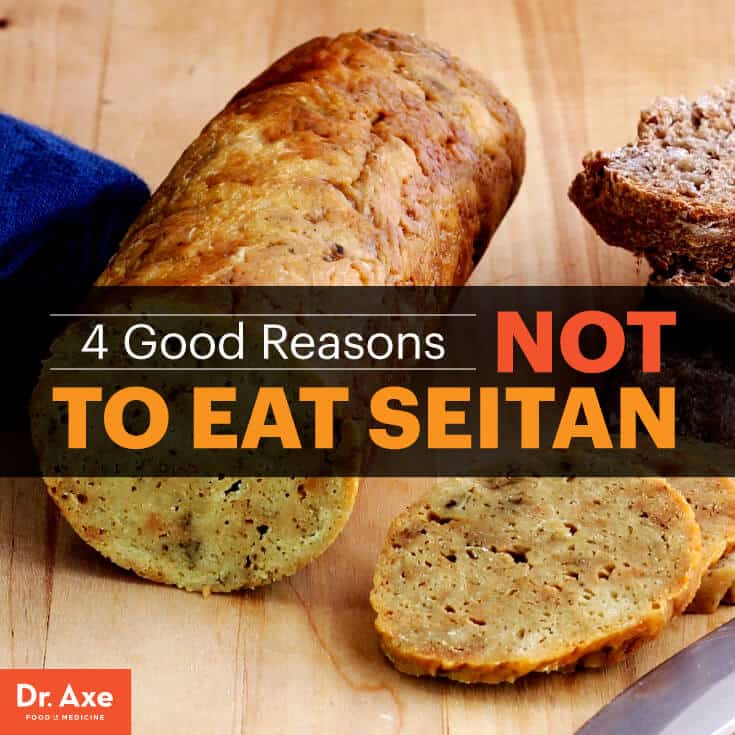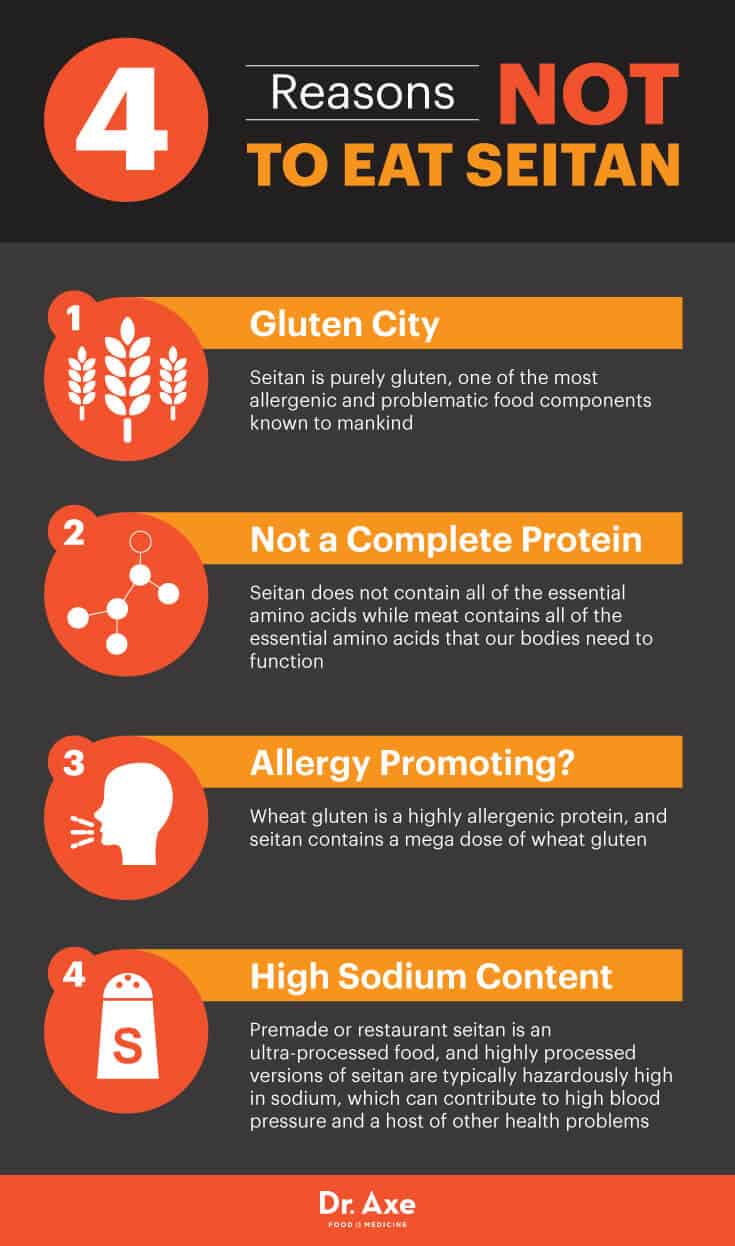
Often called “wheat protein,” “wheat meat” or “wheat gluten,” seitan (pronounced say-tahn) has a look and texture shockingly similar to meat when it’s cooked, and its alternative namesakes are quite fitting since it’s made from gluten, the main protein found in wheat. Most of the commonly consumed meat substitutes are made from soy, but seitan does not contain any soy whatsoever. Are you still wondering: What is seitan? It’s literally one ingredient: wheat gluten.
If you have celiac disease, a serious autoimmune disorder where the consumption of gluten leads to significant damage to the small intestine, then you absolutely want to steer clear of seitan. If you’re sensitive to gluten, you’ll also want to avoid it. What about everyone else? Wheat gluten is a highly allergenic protein, which is why I strongly believe that seitan is not truly a health food and should be avoided by not only gluten avoiders, but everyone — and following are four reasons why.
4 Reasons to Not Eat Seitan
1. Gluten City
So again, seitan is the gluten component of wheat. It’s purely gluten. So for anyone who has celiac disease, a gluten sensitivity or is just generally looking to reduce the amount of gluten in his or her diet, this is not a food you want to eat.
Gluten-free recipes are super popular these days. Everyone seems to be trying to reduce gluten intake. People are even cutting out food products that have very small amounts of gluten. Well, seitan is atop of the list when it comes to gluten-heavy foods. You literally can’t get more gluten-centric than a meat substitute purely made from wheat gluten.
2. Not a Complete Protein
Seitan and lean meat may have similar amounts of protein, but they’re by no means equatable. Seitan does not contain all of the essential amino acids while meat contains all of the essential amino acids that our bodies need to function. Seitan might be a protein food, but it cannot be classified as a complete protein. (1)
Why are amino acids important? Our bodies require amino acids in order to create proteins that repair body tissue, enable growth and break down food. Amino acids also assist with muscle control, muscle tissue formation and protection of the body’s nervous system. In addition, they increase the production of growth hormones in the body, such as testosterone. It’s clearly highly important that we all consume foods rich in amino acids on a regular basis.
3. Allergy Promoting?
Seitan recently made a recent list of “7 Foods a Nutritionist Would Never Eat.” Many health experts stay away from seitan because, like me, they really don’t believe it to be a healthy form of protein. Wheat gluten is a highly allergenic protein. When you consume most wheat-centric products, like wheat bread, there is naturally going to be a small amount of wheat gluten present. What’s more concerning is when you see “wheat gluten” added to the bread. This definitely means that the gluten content is higher. Commercial bakers typically like to add a lot of extra gluten to their products, especially whole wheat breads, since whole wheat flour has a lower gluten density than white flour.
When it comes to seitan, you just get a mega dose of wheat gluten. There might not be seitan-specific research yet, but it’s hypothesized that eating gluten-heavy foods like seitan may increase gluten allergies and gluten intolerance symptoms. If you don’t already have a problem with gluten or wheat, you certainly don’t want to consume anything to promote one.
Once you have a food allergy or sensitivity to gluten or wheat, whenever you consume a product containing these ingredients it’s going to trigger inflammation in your body — and as I always try to remind my readers, inflammation is at the root of most diseases.
4. High Sodium Content
Most people who eat seitan probably don’t make it at home. They most likely eat it at restaurants or buy it pre-made at the store. This seitan is almost definitely an ultra-processed food. These highly processed versions are typically hazardously high in sodium, which can contribute to high blood pressure and a host of other health problems.
For example, a half cup of one pre-made seitan contains 576 milligrams of sodium. (2) That’s about 25 percent of your daily allowance right there. These overly processed seitans typically contain other filler ingredients that may or may not be bad for your health (like sugar). So unless someone is making seitan at home, it most likely is going to be loaded with unhealthy additives, and that’s not healthy for anyone, especially if you already struggle with hypertension or heart problems.

What Is Seitan + Seitan Nutrition
Seitan is a word of Japanese origin that when roughly translated it means “made of proteins.” It’s created by washing wheat flour dough with water until all the starch granules have been removed, leaving only the sticky insoluble gluten as an elastic, taffy-like mass. This mass is then cut into pieces and cooked before being eaten. That’s seitan. It truly is straight-up wheat gluten. It’s quite dense, which makes it more similar to meat than the other meatless proteins, and it has a neutral flavor and tends to absorb flavors well.
Vital wheat gluten is the natural protein found in wheat. It’s commonly used to create seitan. It’s also used in bread recipes — it’s what makes the bread rise. Historically, seitan has been very common in Japan and China as well as other East and Southeast Asian countries. It’s said that wheat gluten came about as an edible product when it was first used as an ingredient for Chinese noodles in the sixth century. (3)
Commercial production of this form of wheat gluten began in 1962 by the Marushima Shoyu Co., which created its seitan product for George Ohsawa and his students. (4) Ohsawa is the founder of the Macrobiotic diet and philosophy. Today, you can easily find seitan in vegetarian dishes in China and around the world. It’s especially popular as a meat substitute for Buddhist vegetarians.
Unless you make it from scratch, the majority of seitan that you buy in stores or eat out at restaurants contains some other ingredients in addition to gluten. Spices are common ingredients in seitan, which isn’t concerning, but other fillers can be added as well. Some may be healthy, but some may not be so healthy. An example of one product sold as “seitan” contains: water, vital wheat gluten, red beans, sprouted lentils, brown sugar, sea salt, spices and garlic.
Pure vital wheat gluten has one ingredient — wheat gluten— and a quarter cup contains about: (5)
- 120 calories
- 4 grams carbohydrates
- 23 grams protein
- 0.5 gram fat
- 1 gram fiber
- 1.8 milligrams iron (10 percent DV)
- 20 milligrams calcium (2 percent DV)
Seitan nutrition is really only impressive for its protein content and decent iron content, but it’s really not a health food, as I’ve laid out.
In addition, one ounce of most vital wheat gluten contains about: (6)
- 104 calories
- 3.9 grams carbohydrates
- 21 grams protein
- 0.5 gram fat
- 0.2 gram fiber
- 11.1 micrograms selenium (16 percent DV)
- 1.5 milligrams iron (8 percent DV)
- 72.8 milligrams phosphorus (7 percent DV)
- 39.8 milligrams calcium (4 percent DV)
- 0.1 milligram copper (3 percent DV)
- 7 milligrams magnesium (2 percent DV)
- 0.2 milligram zinc (2 percent DV)
Better Alternatives to Seitan
Tempeh is a much better meatless protein source than seitan because it’s actually health-promoting. What is tempeh? It’s a traditional fermented soy food originating from Indonesia. Whole soybeans are soaked, dehulled and partly cooked before going through a natural culturing and controlled fermentation process that then binds the soybeans into a cake form. This tempeh cake is then typically cut into slices or cubes before use. Tempeh’s fermentation process and use of the whole soybean give it a higher content of protein vitamins and minerals.
If you come across some delicious-sounding seitan recipes, tempeh can make a great substitute for that glutenous seitan. When you’re considering tempeh vs. tofu, always choose tempeh. Unfermented soy products like tofu are extremely health-hazardous. It’s the fermentation process that can make soy a health food, as is the case with tempeh.
Another better alternative to vital wheat gluten is the fermented soy superfood known as natto. The key this fermented food’s health benefits is that very fermentation. Natto is created by soaking whole soybeans, then steaming or boiling them, and afterward adding the bacteria Bacillus subtilis to the mixture. It’s then allowed to ferment over time. Natto definitely has a smell (like cheese) and a texture (very gooey) that can be hard to get used to for some, but once you do get accustomed to natto’s uniqueness, it can become an excellent source of protein in your next meal.
Traditionally in Japan, natto is a eaten at breakfast along with rice, miso soup and fish. One of the easiest and most common ways to include natto in your diet is to add it to rice dishes after cooking so you don’t destroy the good bacteria. You can also add it to salads and noodle dishes. Natto adds not only vegan-approved protein to a meal, but it also adds a very unique flavor, probiotics, and many vital nutrients, including vitamin K, vitamin C, riboflavin, thiamine and vitamin B6.
Final Thoughts on Seitan
Seitan may be free of meat and also free of soy, but it’s made of something else that so many people are trying to avoid for the sake of their health these days: gluten. You can’t find a more gluten-centric food than seitan, which is purely wheat gluten. If you have a wheat allergy, gluten allergy or both, seitan is truly a dangerous choice of protein for you.
If you don’t have these allergies already, seitan might bring them on since wheat gluten is such a highly allergenic food. If you are a meat eater, you’re much better off sticking with high-quality meat like grass-fed beef, which is a complete protein (unlike seitan) providing your body with essential amino acids as well as anti-inflammatory fatty acids. If you don’t eat meat, I really hope you will turn to healthier meatless options like tempeh or natto.
Seitan may provide protein and a couple of nutrients, but it’s way too commonly allergy-promoting and often overly processed to be considered a healthy option.